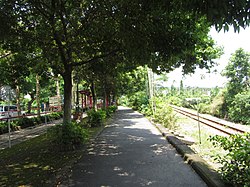ജിജി, നാന്റോ
തായ്വാനിലെ നാൻറ്റൗ കൗണ്ടിയുടെ പടിഞ്ഞാറൻ മധ്യഭാഗത്ത് സ്ഥിതിചെയ്യുന്ന ഒരു നഗര ടൗൺഷിപ്പ് ആണ് ജിജി (Chinese: 集集; pinyin: Jíjí; Wade–Giles: Chi2-chi2; Pe̍h-ōe-jī: Chi̍p-chi̍p) അല്ലെങ്കിൽ ചിച്ചി. വിസ്തീർണ്ണം അനുസരിച്ച് തായ്വാനിലെ ടൗൺഷിപ്പുകളിൽ ഏറ്റവും ചെറുതാണ് ജിജി.
ജിജി ടൗൺഷിപ്പ് 集集鎮 Chi-Chi | |
|---|---|
 Rail tracks of the Jiji Line | |
 നാന്റോ കൗണ്ടിയിലെ ജിജി ടൗൺഷിപ്പ് | |
| Location | നാന്റോ കൗണ്ടി, തായ്വാൻ |
| • ആകെ | 50 ച.കി.മീ.(20 ച മൈ) |
(July 2018) | |
| • ആകെ | 10,887 |
| • ജനസാന്ദ്രത | 220/ച.കി.മീ.(560/ച മൈ) |

ജിജി റെയിൽവേ ലൈനിലെ ഒരു പ്രധാന സ്ഥലമാണ് ടൗൺഷിപ്പ്. 2012 മാർച്ചിൽ, തായ്വാനിലെ ടൂറിസം ബ്യൂറോ മികച്ച 10 ചെറുകിട ടൂറിസ്റ്റ് നഗരങ്ങളിലൊന്നായി ഇത് തിരഞ്ഞെടുക്കപ്പെട്ടു.[1]
ചരിത്രം
തിരുത്തുക1771 മുതൽ ഷാങ്ഷൗവിൽ നിന്നുള്ള ഹാൻ ചൈനീസ് ഈ പ്രദേശത്ത് എത്തിത്തുടങ്ങി. [2] ഫോർമോസൻ ഭാഷകളിലെ ഒരു ശൈലിയായ "ചിവ്-ചിവ്" എന്നതിൽ നിന്നാണ് ഈ പേര് ഉത്ഭവിച്ചത്.
ജാപ്പനീസ് കാലഘട്ടത്തിൽ (1895-1945), ചുറ്റുമുള്ള പ്രദേശങ്ങളിൽ ഉൽപാദിപ്പിച്ചിരുന്ന കർപ്പൂര ശേഖരണത്തിന്റെ ചരക്കുകയറ്റുന്ന കപ്പൽ സ്ഥാനവുമായിരുന്നു ജിജി. 1940 ആയപ്പോഴേക്കും ഷാഷു ടൗൺ (ജാപ്പനീസ്: 集集 街), നിതാക ഡിസ്ട്രിക്റ്റ് (新 郡), ആയി തായ്ചു പ്രിഫെക്ചർ ഭരണം നടത്തി. ജിജി ടൗൺഷിപ്പ് പിന്നീട് ഒരു വലിയ പ്രദേശം ഉൾക്കൊള്ളുകയും ഇന്നത്തെ ഷൂയിലി ടൗൺഷിപ്പ് കൂടി ഉൾപ്പെടുത്തുകയും ചെയ്തു.
1946-ൽ നിതാക ജില്ലയെ യുഷാൻ ഡിസ്ട്രിക്റ്റ് (玉山 區), തായ്ചുങ് കൗണ്ടി എന്ന് പുനർനാമകരണം ചെയ്തു. അതേ സമയം തന്നെ ജിജി ഒരു ടൗൺഷിപ്പായി മാറി. 1950-ൽ ഷുയിലി ടൗൺഷിപ്പ് ജിജിയിൽ നിന്ന് വേർപെടുത്തി. [3]രണ്ടാം ലോകമഹായുദ്ധസമയത്ത്, ഒരു യുഎസ് ബോംബർ ജാപ്പനീസ് പീരങ്കിപ്പട്ടാളത്തിലെ നാല് വ്യോമസേനക്കാരെ വെടിവച്ചു കൊന്നു. പേരുകേട്ടതും വിനാശകരവുമായ 1999 ചി-ചി ഭൂകമ്പത്തിന്റെ ഉത്ഭവകേന്ദ്രമായിരുന്നു ടൗൺഷിപ്പ്.[4][5][6][7][8][9]തായ്വാനിലെ നാന്റോ കൗണ്ടിയിലെ ജിജി(ചി-ചി)യിൽ 1999 സെപ്റ്റംബർ 21 ചൊവ്വാഴ്ച പ്രാദേശിക സമയം 01:47:12 ന് ഉണ്ടായ 7.3 എംഎൽ അല്ലെങ്കിൽ 7.7 മെഗാവാട്ട് ഭൂകമ്പമായിരുന്നു ഇത്.[10]2,415 പേർ ഇതിൽ കൊല്ലപ്പെട്ടു. 11,305 പേർക്ക് പരിക്കേറ്റു. NT$300 ബില്യൺ നാശനഷ്ടമുണ്ടായി. 1935-ലെ ഷിൻചിക്കു-തായ്ചു ഭൂകമ്പത്തിനുശേഷം, തായ്വാനിൽ രേഖപ്പെടുത്തിയ ചരിത്രത്തിലെ ഏറ്റവും വലിയ രണ്ടാമത്തെ ഭൂകമ്പമാണിത്.
ജനസംഖ്യാശാസ്ത്രം
തിരുത്തുക2016 ഡിസംബർ വരെ 5,745 പുരുഷന്മാരും 5,290 സ്ത്രീകളും ഉൾപ്പെടെ 11,035 ജനസംഖ്യ ജിജിയിലുണ്ട്. [11] ചരിത്രപരമായി, 1970-ൽ ജനസംഖ്യ 16,395 ആയി ഉയർന്നു. അതിനുശേഷം ക്രമാനുഗതമായി കുറഞ്ഞു. ഇതിനു വിപരീതമായി, കുടുംബങ്ങളുടെ എണ്ണം 1970-ൽ 2,772 ൽ നിന്ന് 2014-ൽ 4,376 ആയി ഉയർന്നു, 2016 ആയപ്പോഴേക്കും ഇത് 4,308 ആയി കുറഞ്ഞു.[12]
ഭൂമിശാസ്ത്രം
തിരുത്തുകജിജിയുടെ അതിർത്തിയിൽ വടക്ക് സോങ്ലിയാവോ, പടിഞ്ഞാറ് മിങ്ജിയാൻ, തെക്ക് സുഷാൻ, ലുഗു, കിഴക്ക് ഷൂയിലി ടൗൺഷിപ്പിന്റെ തെക്കേ അതിർത്തിയിലൂടെ പടിഞ്ഞാറോട്ട് ചോഷുയി നദി ഒഴുകുന്നു. ജിജി ടൗൺഷിപ്പിന്റെ ആകെ വിസ്തീർണ്ണം 49.72 ചതുരശ്ര കിലോമീറ്ററാണ്. ടൗൺഷിപ്പിലെ ഏറ്റവും താഴ്ന്ന സ്ഥലം സമുദ്രനിരപ്പിൽ നിന്ന് 230 മീറ്റർ ഉയരത്തിലാണ്. അതിന്റെ ഏറ്റവും ഉയർന്ന സ്ഥലം സമുദ്രനിരപ്പിൽ നിന്ന് 1392 മീറ്റർ ഉയരത്തിലുള്ള ബിഗ് ജിജി പർവ്വതമാണ് (集集). ടൗൺഷിപ്പ് എല്ലാ ഭാഗത്തും വളരെയധികം പർവ്വതങ്ങളാൽ ചുറ്റപ്പെട്ട പർവ്വതപ്രദേശമാണ്. [13]
അഡ്മിനിസ്ട്രേറ്റീവ് ഡിവിഷനുകൾ
തിരുത്തുകഎലിയാവോ, ബസാങ്, ഫുഷാൻ, ഗുവാങ്മിംഗ്, ഹെപ്പിംഗ്, ജിജി, ലിൻവെയ്, ടിയാൻലിയാവോ, യോങ്ചാങ്, യുയിംഗ്, വുക്വോ എന്നീ 11 ഗ്രാമങ്ങളായി ജിജിയിൽ ഭരണ നിർവ്വഹണം നടത്തിയിരിക്കുന്നു.
രാഷ്ട്രീയം
തിരുത്തുക2014-ലെ മേയർ തെരഞ്ഞെടുപ്പിൽ പുതുതായി രൂപംകൊണ്ട ട്രീസ് പാർട്ടിയുടെ 29 കാരനായ ചെൻ ചി-ഹെംഗ് വിജയിച്ചു. ഇത് മാധ്യമങ്ങളെ അതിശയിപ്പിച്ചിരുന്നു.[14]
വിനോദസഞ്ചാര കേന്ദ്രങ്ങൾ
തിരുത്തുകഅവലംബം
തിരുത്തുക- ↑ Wong, Maggie Hiufu (2012-03-30). "Taiwan names its 10 top small tourist towns". CNN Go. Retrieved 2012-03-31.
- ↑ "About Chichi(關於集集)" (in Chinese). 2007-02-22. Archived from the original on 8 February 2007.
{{cite web}}: CS1 maint: unrecognized language (link) - ↑ "集集镇". zh:集集鎮#歷史. Wikipedia (Chinese).
{{cite web}}: Missing or empty|url=(help) - ↑ "Taiwan earthquake of 1999". Encyclopædia Britannica Online. 14 September 2019. Archived from the original on 6 September 2018. Retrieved 21 September 2019.
Taiwan earthquake of 1999, also called 1999 Chi Chi earthquake, earthquake that began at 1:47 AM local time on Sept. 21, 1999, below an epicentre 93 miles (150 km) south of Taipei, Taiwan.
- ↑ "About the Conference". ChiChi20. Retrieved 21 September 2019.
The International Conference in Commemoration of 20th Anniversary of the 1999 Chi-Chi Earthquake will be held in Taipei, Taiwan from September 15th to September 19th, 2019.
- ↑ "Fault Dynamics of the 1999 Chi-Chi earthquake: clues from nanometric geochemical analysis of fault gouges". Scientific Reports. 2019. Retrieved 21 September 2019.
Here, we report on the results of studies made on the fault dynamics of the 1999 Chi-Chi earthquake (Mw 7.6) through identifications of the changes in the grain-morphology and chemical composition resulting from fault movement.
{{cite journal}}: Unknown parameter|authors=ignored (help) - ↑ 慈濟人道救援國際肯定 顏博文多國研討會分享. 蕃新聞 (in Chinese (Taiwan)). 21 September 2019. Retrieved 21 September 2019.
慈濟基金會響應防災政策,顏博文執行長以全英文發表「Tzu Chi Disaster Relief Model In 1999 Chi-Chi Earthquake」。
- ↑ Lin Chia-nan (28 March 2019). "Study on crustal changes after 921 quake unveiled". Taipei Times. Archived from the original on 3 September 2019. Retrieved 21 September 2019.
The team detailed their findings in a paper titled "Lower-crustal rheology and thermal gradient in the Taiwan orogenic belt illuminated by the 1999 Chi-Chi earthquake" which was published in the journal Science Advances.
- ↑ "2000 Year In Review; 2002 Year in Review". pp. 52, 53, 92 – via Internet Archive.
Kao, H., and Chen, W.-P., 2000, The Chi-Chi earthquake sequence: Active out-of-sequeence thrust faulting in Taiwan: Science, 288: 2346-2349
- ↑ Çelebi, M (2000-12). "Revelations from a single strong-motion record retrieved during the 27 June 1998 Adana (Turkey) earthquake". Soil Dynamics and Earthquake Engineering. 20 (5–8): 283–288. doi:10.1016/s0267-7261(00)00061-0. ISSN 0267-7261.
{{cite journal}}: Check date values in:|date=(help) - ↑ 村里鄰人口數 [Population figures by rural village/urban village/neighborhood]. jijihr.nantou.gov.tw (in Chinese). Jiji Township Household Registration Office. December 2016. Retrieved 2017-01-27.
{{cite web}}: CS1 maint: unrecognized language (link) - ↑ 歷年人口數 [Historical population figures]. jijihr.nantou.gov.tw (in Chinese). Jiji Township Household Registration Office. Retrieved 2017-01-27.
{{cite web}}: CS1 maint: unrecognized language (link) - ↑ 地理氣候 [Geography & climate]. www.chi-chi.gov.tw (in Chinese). Jiji Township Office. December 2015. Retrieved 2017-01-27.
{{cite web}}: CS1 maint: unrecognized language (link) - ↑ 集集鎮長陳紀衡當選,太陽花學運如何改變一個人 (in Chinese), Commonwealth Magazine, 2014-12-07
{{citation}}: CS1 maint: unrecognized language (link) - ↑ "Sun Moon Lake National Scenic Area > Tourist Guide > Scenic Spots Introduction". Sunmoonlake.gov.tw. Archived from the original on 2014-02-19. Retrieved 2014-05-01.
- ↑ Shan, Shelley (28 April 2017). "Faster access to the Jiji line launched". Taipei Times. Retrieved 12 October 2017.
- ↑ "集集軍史公園". Ttvs.cy.edu.tw. Archived from the original on 2008-06-18. Retrieved 2014-05-01.
- ↑ "JiJi Diversion Weir". Central Region Water Resources Office, Water Resources Agency, Ministry of Economic Affairs. 15 July 2011. Archived from the original on 2018-08-11. Retrieved 11 August 2018.
- ↑ "Attractions > Hot Spots > Nantou County > Mingxin Academy >". taiwan.net.tw. Archived from the original on 2018-11-28. Retrieved 2019-11-22.
പുറത്തേക്കുള്ള കണ്ണികൾ
തിരുത്തുകവിക്കിവൊയേജിൽ നിന്നുള്ള ജിജി, നാന്റോ യാത്രാ സഹായി
- Jiji Township Office Archived 2010-06-03 at the Wayback Machine. (in Chinese)